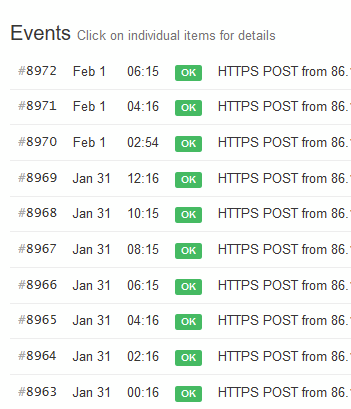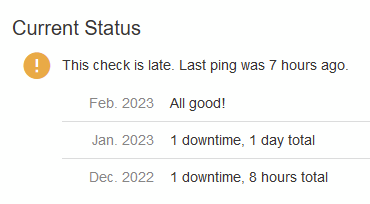Warning: Rant alert incoming!!!
@gchen,
About a year ago you mentioned in an admirably open manner that Duplicacy-Web was not the commercial success you hoped it to be. In my opinion the statement above perfectly embodies why it never had a chance to be one and why it doesn’t deserve to be one. I understand that this is some harsh criticism, but I believe it is justified. Please allow me to explain, based on my experience.
I have three Duplicacy-Web lifetime licenses and one of them powers the MacBook Air of a family member living 9 times zones away. Her backups are stored on a NAS in my own home network. She is not computer-savvy and not particularly interested in it. In other words she’s the perfect “normal” user, who just wants things to work reliably and not have to tinker with something that in most cases she can’t fix anyway. It is also nearly impossible to get remote access to her computer, just because she’s always on the go and a difference of 9 time zones makes it even more difficult.
In July or August of 2021 I visited her and updated her MacBook to the then-latest version of Duplicacy-Web. I did a test run of the backup after rebooting her machine and things looked fine. Around September or Oktober I checked into her backup data from my local installation of Duplicacy-Web and noticed that I wasn’t getting any more backup versions from her Mac. I tried to schedule a session with her to take a look at things, but - as usual - she was just too busy. In April of 2022 I visited her again and noticed that the backup failed due to a license issue, even though at first glance the hostname matched. After some tinkering (changing the hostname in the Duplicacy web portal and then later changing it back) I finally got the license check to pass and directly launching a backup seemed to work again. Except when I rebooted her machine and let the scheduled backup kick in, it failed again with a license check failure.
At this point I simply gave up, because I didn’t have the time or the inclination to issue a support request for a machine that I have no reliable access to. Strangely enough a few weeks later her backups started coming in again. Though - as I just now noticed - her last backup was from two weeks ago, not sure why they stopped again.
Of course during all this I was never aware in a timely manner when a problem occurred, because the Web-app doesn’t provide the option to just email you, when they are problems, you either get emails or you don’t. And I always opt for don’t. That’s why I also missed that my own local backups stopped working at some point last year and only noticed it three weeks later. The problem was easily fixed (by deleting and recreating the docker container for Duplicacy-Web on my NAS), but one needs to know that a problem exists without being constantly bombarded with the “news” that everything is working fine.
Why am I telling you this? Because it demonstrates a few of the ways in which Duplicacy-Web as a product keeps failing me. The engine seems to work fine, but the user interaction with the product is a nuisance and the overall solution is just not reliable. It’s like a high-maintenance romantic partner that constantly needs an inordinate amount of attention for the relationship to not fall apart. And I don’t want a romantic relationship with my backup software, I want a professional relationship, where the professional/software does the job in a reliable manner, reaching out to me only when there’s a problem with doing the job, but otherwise leaves me alone.
As @saspus pointed out, you’ve been previously alerted to the problem with the current license verification logic and alternatives were suggested, yet apparently the feature is as unreliable as ever (even though (fixing it might have become a little easier). But that’s only touching up the symptoms and that only matters, if you a) notice the problem in a timely manner and b) have (local or remote) access to the machine. Those of us who (remotely) provide tech support to family members won’t have a) and frequently don’t have b) either. Thus we need the solution to not fail in the first place, if it can be avoided. And in the case of the licensing logic many fails can definitely be avoided, as more robust alternatives have been pointed out to you.
But just as you didn’t heed suggestions made years ago, that you provide an option to have Duplicacy-Web sent out emails only in case an error occurred, you didn’t heed the suggestion re. reliability improvements for the license verification. And all you have to say now is that you don’t want to change it. (The implication being “the customer be dammed” or “let them eat cake”.)
While it’s understandable that you can’t implement every suggestion, at this point in time Duplicacy-Web is still the same clunky mess that it was years ago, except years ago I still had hopes that it would improve over time. Well it did not.
And at this point I have given up any and all hope that Duplicacy-Web can ever be a low-maintenance solution and I expect it to always be a high-maintenance proof of concept, masquerading as a product. Thus I have stopped recommending it to friends and family and in December of last year. I bought a set of licenses from another backup software. I can’t say that it’s a competing product, because as I said, I don’t consider Duplicacy-Web to be a “product” anymore. For as long as it runs on my machine, I’ll still use it for backups, but at this point I consider it my tertiary backup “solution”, the other two are the relevant ones for me. I’m also going to migrate said family member’s MacBook Air to the recently bought backup software, so I won’t have any more hassles with that.
To the OP of this thread and anybody else reading this, I strongly suggest that you abandon the Web version of Duplicacy, if you want a reliable solution. Either go with the command-line version and write your own scripts around it, if you can. Or if you don’t have the time or inclination for that (like I don’t), look for another software, either a separate backup solution or perhaps a 3rd party management software that can decently integrate the command-line version of Duplicacy.(if such a thing exists).
Well, I think it’s way past time that I step off my soapbox. I suppose that I may ruffle some feathers here, but that’s okay. The time for gentle nudging is long over. In any case I don’t expect anything in the “product” to change for the better, but perhaps my musings will calibrate the expectation of those who have the patience to read through all of them.
Best of luck to everyone!




